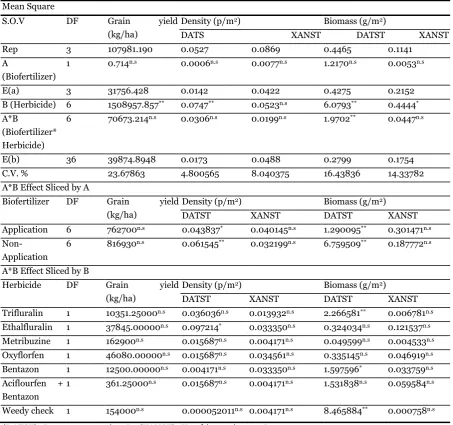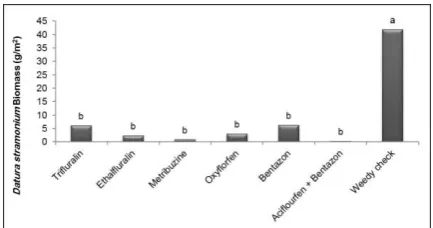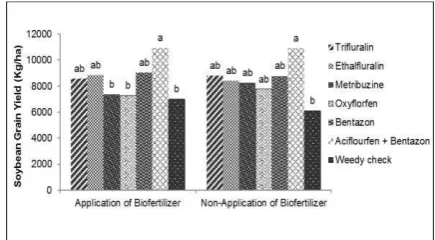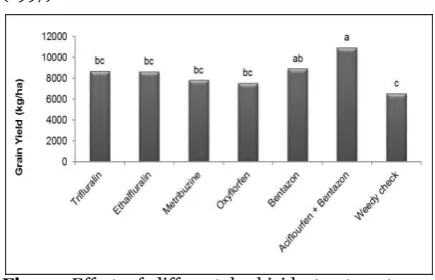35 Vaziritabar et al.
RESEARCH PAPER
OPEN ACCESS
Evaluation of biofertilizer effect on selective soybean
herbicides efficiency to control of
Xanthium spinosom
and
Datura stramonium
Yazdan Vaziritabar
1*, Yavar Vaziritabar
1, Farzad Paknejad
2, Farid Golzardi
3, Sina
Falah Tafty
41
Department of Agronomy, Science and Research Branch of Tehran, Islamic Azad University,
Tehran, Iran
2
Department of Agronomy, Karaj Branch, Islamic Azad University, Karaj, Iran
3
Young Researchers and Elite Club, Karaj Branch, Islamic Azad University, Karaj, Iran
4
Department of Agronomy, Science and Research Branch of Khozestan, Islamic Azad University,
Ahwaz, Iran
Key words:Bradyrhizobium japonicum, grain yield, weed biomass, weed density.
http://dx.doi.org/10.12692/ijb/4.12.35-43
Article published on June 22, 2014
Abstract
This experiment was conducted during 2009 growing season as split plot with randomized complete block (RCBD) design arrangement in a field of Faculty of Agriculture, Islamic Azad University, Karaj branch, Iran. Treating or not treating with
biofeltilizer (Bradyrhizobium japonicum) was the main treatments. The sub-treatments were application of herbicides consisted of trifluralin, ethalfluralin, metribuzine, oxyflorfen, bentazon, aciflourfen+bentazon respectively at 1.2, 1.16, 0.35, 0.48, 1.2, 1.06 kg ha- and weedy check. In this research, application of biofertilizer on efficiency of some herbicides was
effective in decreasing weeds dry weight. The biomass of cocklebur (Xanthium spinosom) in treatments trifluralin, ethalfluralin, aciflurfen+bentazon or bentazon, was significantly less than weedy check, but oxyflorfen and metribuzin had no
significant effect on the biomass of this weed. However, the herbicides, compared with weedy check, had no significant effect on the density of cocklebur. All herbicides, compared with weedy check, significantly reduced the density and biomass of
jimsonweed (Datura stramonium). Regard less of statistic analysis, the mean biomass of jimsonweed in the treatment of aciflourfen+bentazon was less than the other treatments. Application of aciflourfen+bentazon, bentazon compared with weedy
check resulted in significant grain weight of soybean. Compared with weedy check, all treatment except oxyflorfen, increased soybean 1000-grain weight. Although the soybean 1000-grain weight in the treatments aciflourfen+bentazon, bentazon and ethalfluralin was higher than other treatment, but these treatments were not significantly different from metribuzin and
ethalfluralin.
* Corresponding Author: Yazdan Vaziritabar [email protected]
International Journal of Biosciences | IJB |
36 Vaziritabar et al.
Introduction
Lands under soybean plantation in Iran in 2011 were
70 thousand hectare and rate of production was
estimated, 170 thousand tone (FAO, 2013).
Xanthium spinosum L. decreased 70% yield of bean
(Mclelland, 2002). Result of Friesen (1987) showed
the presence 13 plants of Sinapis arvinsis in each
meter of plant line can decrease Helianthus annus L.
yield by ratio of 35%. Shaw et al., (1990) Reported
American farmers spend yearly up to 6.2 billion of
dollars on controlling of farm and pasturage weeds.
From this amount 3.6 billion of dollars goes on
buying 200 million kilograms of herbicides. The
average damage of weeds in corn plantation in Iran is
reported at ratio of 86% (Mousavi, 2001). Hence,
herbicides consumption trend in Iran during the
previous years represented that this measure is going
up. Already just about half of 24 million liter or
kilogram of venom consumption in the term of
agriculture devote to herbicides (Zand et al., 2009).
Hadizade et al., (1998) reported competition between
soybean and weeds cause to morphological changes in
soybean canopy just like plant height, increase in
middle node, decrease diameter of original stem and
decrease in length and number of sub branches.
Stoller & Woolley (1985) reported the unlimited habit
of weeds growth like D. stramonium lead to increase
the length of them. In convergence of crop growth D.
stramonium establishes its leaves on top of the
canopy in order to light competition with crops which
makes it dominant over the main crop (Regnier &
Stoller. 1989; Pike et al., 1990). Stephan & Roskamp
(1998) demonstrated that thifensulfuron at 2.2 to 8.8
g/ha in combination with bentazon at 420 g/ha may
be safely applied to soybean for broadleaf weed
control such as D. stramonium and X. spinosom.
According to Brickell & Jordan (1980) oxyfluorfen, all
at 0.38-0.5 lb/acre and bifenox at 1.5 to 2 lb/acre
gave good selective control of jimsonweed (Datura
stramonium), Capsella bursa-pastoris and
Chenopodium album. Control was less satisfactory
when the treatments were incorporated before sowing
the soybeans. Post-emergence treatments with
acifluorfen and MC 10978 (acifluorfen-sodium) at
0.5, 0.75 and 1 lb/acre also performed well. Ovesen,
(2001) showed application of aciflourfen+bentazon
controlled X. spinosom L. by the rate of 80%. Marwat
et al., (1995) showed interference of Abutilon
theophrasti L. with soybean in each square meter
decreases soybean yield by 35%. Also competition of
10 and 15 A. theophrasti L. in each square meter
decreased soybean yield by 58 and 74, respectively.
Also, they declared weed species which has less height
than corps decreases the yield when they compete for
water. Even though nutrient increase the plant
growth but weeds use it more than crops.
In accordance with sustainable agriculture, some of
soil micro organisms which have symbiosis with
plants and use as biofertilizers to supply food
elements are in extension (Sharma, 2003). These
micro organisms usually are from bacteria, and
equipped with an enzymatic system that enables them
to break the triple bond between two nitrogen
atmospheric atoms and produces ammoniac, that
similar to industrial processes but has no expense for
unrenewable energy resources (Dalla Santa et al.,
2004). In agriculture, herbicides have been used in
large scale. But often, there is no research on their
sub effects. This is very important in crops. Because,
herbicides not only will have adverse effect on plant
growth, also influence on the interaction relation
between symbiosis bacteria just like rhizobioumes
and plant growth promoting bacteria (Brock, 1975).
Studies showed some of the herbicides keep adverse
effect on plants nodulation. These effects on main
roots nodules were more than sub roots. Trifluralin
decreases the growth of sub roots and makes nodules
in soybean (Kust et al., 1971; Eberbachk et al., 1989).
Even though biofertilizer application improved in
Iran their interaction with herbicides are very less
Therefore the aim of this research were efficacy
evaluation of herbicides in control of soybean weeds
and checked their interaction with biofertilizer like
(Bradyrhizobium japonicum), and the effect of
biofertilizer on soybean yield.
Materials and methods
Site description and experimental design
37 Vaziritabar et al.
season as split plot with randomized complete block
(RCBD) design arrangement with four replications in
a field of faculty of agriculture Islamic Azad
University Karaj, Iran.In position of (35° 45˝N, 51°
56˝E; 1313 m above the sea level). This area has
average temperature with relative humidity of 36 to
73 percent and less rain per year (Anonymous, 2009).
Main factors were application and non-application of
biofertilizer (Bradyrhizobium japonicum), with the
population of 2.3˟108 bacteria per each gram. For
every kilogram of soybean seed Glycine max L. ver. of
Williams cultivar an amount of 20 ml of solution was
added and mixed well till all seeds were mixed with
this substance well then seeds were kept in an open
air for a period of half an hour in the shadow then soybean planted after planting soybeans seeds
watering started immediately. The sub-treatments
were application of herbicides consisted of trifluralin
EC 48%, ethalfluralin EC 33.3%, metribuzine WP
70%, oxyflorfen EC 24%, bentazon SL 48%,
aciflourfen+bentazon SL 6.42% respectively at 1.2, 1.16, 0.35, 0.48, 1.2, 1.06 kg ai ha-1 (Vencill, 2002;
Tomlin, 2003) and weedy check. Trifluralin and
ethalfluralin as pre-plant and soil incorporation,
oxyflorfen and metribuzine pre-emergence and other
herbicides applied as post-emergence in 4-6 leaves
stage of soybean. All herbicides were sprayed with
hand lever knapsack sprayer equipped with standard
flat fan T-jet nuzzle and calibrated to deliver 375 L ha -1 of spray solution at a pressure of 2.5 bar.
Immediately after using pre-plant and soil
incorporation herbicide helped the rake to mix them
with soil, Mixed done well, up to depth of 10 cm. Size
of each plot was 2.5 m wide and 6 m length. Plots
length consisted of five rows of plant with 6 m length.
Distance of plots in every block was 50 cm and
distance of blocks from each other was 2 m. Also
distance of plant lines were 50 cm. Sub plots were
managed in such a way that while irrigation, water
should not enter the other plot. All operations like
fertilizing, irrigation, pest control were done
according to the technical advises.
Weed and crop measurements
Evaluation including weeds population was measured
separately for each weed species by counting the
number of weeds 21 days after last treatment (DAT)
within two fixed 0.5 m2 quadrates that were dropped
in to the treated of each plot accidentally which
showed total weeds of that plot. In kernel filling stage
in ear by keeping quadrates 0.5 m2 in two points from
every plot accidentally which declares total weeds of
and then weighted. After harvest, sampling from
seeds was done by each plot. 1000 grain weight in
separate plot was determined.
Data analysis
All data were analyzed statistically using program
procedure in SAS statistical software (SAS institute,
2000). Duncan multiple rang test (DMRT) set at 0.05
was used to determined the significance of the
application bentazon caused chlorosis and leaf
necrosis. These marks appeared as brown stains in
old leaves but had not bad effect on soybean yield.
Appearance of necrotic effects in both original
treatments of biofertilizer application and none
application were same. Other herbicides did not make
any remark on soybean plants.Among native weeds,
analysis in herbicides applications were achieve on
dominant weeds of area and are explained.
Weed Control
Datura stramonium L.
Variance dissolve results (Table 1) showed, despite
none application biofertilizer treatment, the
application of that with bentazon showed no
significant difference in biomass of D.stramonium L.
Also trifluralin with biofertilizer application compare
38 Vaziritabar et al.
biomass of this weed (Figure 1). There was no
significant difference between application and none
application of biofertilizer with herbicide in number
and dry weight of this weed (Figure 1). There was
significant difference by herbicide application in
number and dry weight of this weed in level 1%. In
done evaluations, all herbicides treatments decreased
the number of this weed in ratio of 93-64% and its
biomass in ratio of 99-85% (Figures 2 & 3).
Table 1. Analysis of variance for different biofertilizer, herbicide and their interaction treatments on density and biomass of weeds and soybean grain yield.
Mean Square
S.O.V DF Grain yield (kg/ha)
Density (p/m2) Biomass (g/m2)
DATS XANST DATST XANST
Rep 3 107981.190 0.0527 0.0869 0.4465 0.1141 A
(Biofertilizer)
1 0.714n.s 0.0006n.s 0.0077n.s 1.2170n.s 0.0053n.s
E(a) 3 31756.428 0.0142 0.0422 0.4275 0.2152 B (Herbicide) 6 1508957.857** 0.0747** 0.0523n.s 6.0793** 0.4444*
A*B
(Biofertilizer* Herbicide)
6 70673.214n.s 0.0306n.s 0.0199n.s 1.9702** 0.0447n.s
E(b) 36 39874.8948 0.0173 0.0488 0.2799 0.1754 C.V. % 23.67863 4.800565 8.040375 16.43836 14.33782 A*B Effect Sliced by A
Biofertilizer DF Grain yield (kg/ha)
Density (p/m2) Biomass (g/m2)
DATST XANST DATST XANST Application 6 762700n.s 0.043837* 0.040145n.s 1.290095** 0.301471n.s
Non-Application
6 816930n.s 0.061545** 0.032199n.s 6.759509** 0.187772n.s
A*B Effect Sliced by B
Herbicide DF Grain yield (kg/ha)
Density (p/m2) Biomass (g/m2)
DATST XANST DATST XANST Trifluralin 1 10351.25000n.s 0.036036n.s 0.013932n.s 2.266581** 0.006781n.s
Ethalfluralin 1 37845.00000n.s 0.097214* 0.033350n.s 0.324034n.s 0.121537n.s
Metribuzine 1 162900n.s 0.015687n.s 0.004171n.s 0.049599n.s 0.004533n.s
Oxyflorfen 1 46080.00000n.s 0.015687n.s 0.034561n.s 0.335145n.s 0.046919n.s
Bentazon 1 12500.00000n.s 0.004171n.s 0.033350n.s 1.597596* 0.033759n.s
Aciflourfen + Bentazon
1 361.25000n.s 0.015687n.s 0.004171n.s 1.531838n.s 0.059584n.s
Weedy check 1 154000n.s 0.000052011n.s 0.004171n.s 8.465884** 0.000758n.s
(DATST): Datura stramonium L., (XANST): Xanthium spinosom L
ns: not-significant
**,* means within each column followed by same letter are not significantly different according to Duncan’s
multiple range test at the 1 % and 5 % probability level.
Xanthium strumarium L.
Variance dissolve results (Table 1) showed there is no
significant difference between application and none
application of biofertilizer in density and biomass of
X. strumarium L. Also no significant difference was
observed in interaction of biofertilizer with herbicide.
Evaluations showed neither of herbicides treatment
could affect on decreasing density of X. strumarium
L. compared to weedy check (Figure 4). Whereas
39 Vaziritabar et al.
trifluralin application respectively decreased weed
biomass by rate of 78, 70, 55 and 38.59% compare to
weedy check. Oxyflorfen had no efficacy on this weed
biomass (Figure 5).
Fig. 1. Comparison of Datura stramonium dry weight in treatment's experiment. Mean within each
column followed by same letter are not significantly
different (Duncan 5%).
Fig. 2. Effect of different herbicide treatments on jimsonweed (Datura stramonium) populations
reductions. Means within each column followed by
same letter are not significantly different (Duncan
5%).
Soybean Grain Yield
Variance dissolve results (Table 1) showed although
interaction between biofertilizer with herbicide had
no significant efficacy on grain yield, there were
significant differences in categorizing treatments in
variance dissolve results between those. As in both
fertilizer conditions just aciflourfen+bentazon had
maximum grain yield compare to weedy check. But in
this province other herbicides did not have any
significant differences compare to weedy check
(Figure 6). There were significant differences
between herbicides treatment in level of 1%. Among
herbicides aciflourfen+bentazon had maximum grain
yield which was statistically equaled with bentazon.
The least grain yield rate was belonged to weedy
check and all of the herbicides treatments increased
grain yield. Grain yield weight in
aciflourfen+bentazon by rate of 40% was more than
weedy check and other treatments (Figure7).
Fig. 3. Effect of different herbicide treatments on jimsonweed (Datura stramonium) biomass
reductions.Means within each column followed by
same letter are not significantly different (Duncan
5%).
Discussion
At present in Iran there is no report in relation with
herbicides interaction on biofertilizers. Herbicides are
used in broad level in agriculture. But there is no
research on their sub effects. This matter has special
importance about cereals. Because herbicides not
only will have adverse effect on plant growth, also
influence on the interaction relation between
symbiosis bacteria just like rhizobioumes and plant growth promoting bacteria (Brock, 1975). Studies
showed some of the herbicides keep adverse effect on
plants nodulation. These effects on main roots
nodules were more than sub roots. Trifluralin
decreases the growth of sub roots and makes nodules
in soybean (Kust et al., 1971; Eberbachk et al., 1989). Bollich et al., (1988) reported that pendimetalin and
trifluralin made disturbance in soybean germination
and decreased number of nodes, dry weight and
nitrogen fixed, but had no inhibition effect on
nodulation and nitrogen fixation in grain yield. Upon
experiments, pre-emergence application of alachlore
and metribuzine decreased nodulation in soybean
root but had no negative effect on grain yield (Mallik
et al., 1985). Moorman (1986) reported a reduction in
soybean-node-weight by treating alachlor, linuron
and trifluralin herbicides without any diminishing in
crop yield. Eberbachk et al., (1989) reported the
40 Vaziritabar et al.
nodulation. Dunigan et al.,(1972) reported 2,4-D and
MCPA herbicides stopped different verities of
rhizobioums activity. Brock, (1975) reported dalapon
treatment had no effect on nodes number or total
weight in bird foot clover, also 2,4-DB decreases the
both of mentioned subjects. Rennie et al., (1984)
Reported nitralin and prometryn treatments had
harmful effects on soybean nodulation and also
linuron and trifluralin treatments respectively
decreased nodules in soybean by ratio of 1.12 and
0.84 kg ha-1. Mallik et al., (1985) reported
pre-emergence applications of alachlor and metribuzine
at 1.7 and 0.34 kg ha-1 in soybean significantly
decreased nodulation; nitrogenize activity and total
amount of nitrogen. Also trifluralin at 0.56 kg ha-1
decreased nodulation and nitrogenizes activity.
Fig. 4. Effect of different herbicide treatments cocklebur (Xanthium spinosom) population
reductions. Means within each column followed by
same letter are not significantly different (Duncan
5%).
Fig. 5. Effect of different herbicide treatments cocklebur (Xanthium spinosom) biomass
reductions.Means within each column followed by
same letter are not significantly different (Duncan
5%).
Therefore, with regards to above statements,
nodulation and azote biological fixation by plant
growth promoting bacteria such as Bradyrhizobium
japonicum in crops like soybean can be under
impression of environmental circumstances and
various herbicides. In such, these herbicides cause to
reduction or inefficacy of plant growth promoting and
azote biological fixation current in crop plants, in this
research nodulation was not occur which needs more
researches.
Fig. 6. Comparison of soybean grain yield in treatment's experiment. Mean within each column
followed by same letter are not significantly different
(Duncan 5%).
Stephan & Roskamp (1998) demonstrated that
thifensulfuron at 2.2 to 8.8 g/ha in combination with
bentazon at 420 g/ha may be safely applied to
soybean for broadleaf weed control such as D.
stramonium and X. spinosom. Veldon et al., (1987)
showed in greenhouse condition bentazon and aciflourfen applications are effective on decrease rate
of moisture percentage in D. Stramonium L., even
though bentazon was more effective than aciflourfen
to decrease density and biomass of this weed.
Karaminejad et al., (2010) reported among the
herbicides treatment, application of metribuzine
effectively controlled D. stramonium L. in range of
64-77%. According to Brickell & Jordan (1980)
oxyfluorfen, all at 0.38-0.5 lb/acre and bifenox at 1.5
to 2 lb/acre gave good selective control of
D.stramonium and C. album. Control was less
satisfactory when the treatments were incorporated
before sowing the soybeans. Post emergence
treatments with acifluorfen and MC 10978
(acifluorfen-sodium) at 0.5, 0.75 and 1 lb/acre also
performed well. Weaver, (1991) showed metribuzine
application had major role in decrease of X. spinosom
41 Vaziritabar et al.
Suitable control of this weed by the herbicides were
related to low density of it compare to X. spinosom L.
McWhorter and Anderson (1976 a,b); Weaver, (1980)
reported post-emergence application of bentazon at
1.1-0.6 kg ha-1 and aciflourfen at 1.1 kg ha-1 had
satisfactory control on X. stramonium L. in soyabean.
The suitable control of this weed by applied
herbicides is because of D. stramonium
photosynthesis process and also lower profusion
compare to X. spinosom. Ovesen, (2001) showed
application of aciflourfen+bentazon controlled X.
spinosom L. by the rate of 80%. Suitable control of
this weed by mentioned herbicide is related to better
absorption of herbicides by this weed. Because of
trifluralin and ethalfluralin are pre-plant and soil
incorporation herbicides and aciflourfen+bentazon
are post-emergence herbicides. Kapusta, et al (1986)
reported bentazon treatment application at 0.8 and
1.1 kg ha-1 and aciflourfen at 0.4 and 0.6 kg ha-1 did
not decrease soybean yield. Fronning & Kegode,
(2004) in their research to control of Artemisia
biennis L. in soybean in Wyndmere showed,
bentazon+aciflourfen at 240+120 g ha-1 had suitably
controlled as good as weed free treatment and
increase soybean yield. Also bentazon at 560 g ha-1
ranked in next step. Research at almond to control A.
retroflexus L. with aciflourfen+bentazon at advised
doses marvelous increase yield achieved Grichar,
(1997).
Fig. 7. Effect of different herbicide treatments on soybean grain yield. Means within each column
followed by same letter are not significantly different
(Duncan 5%).
Since in this experiment all herbicides decreased the
dry weight of weeds, then relative increase by
oxyflorfen+bentazon treatment can be related to
decrease of weeds biomass in these treatments or can
be attributed to better absorption of herbicides via
weed, because trifluralin and ethalfluralin are
pre-plant soil incorporation herbicide and mixture of
aciflurfen plus bentazon is pre-emergence.
References
Anonymous. 2009. Statistics of Aerology institute.
www.weather.ir.
Bollich PK, Dungun EP, Kiochell LM, Taylor V. 1988. The influence of Trifluralin and pendimethalin on nodulation, N2 (C2H2) fixation, and
seed yield of field-grown soybeans (Glycine max).
Weed Science 36, 15-19.
Brickell CM, Jordan GL. 1980. Comparison of diphenyl ether herbicides for weed control in
soybeans. Proceedings North Central Weed Control
Conference. 11.
Brock L.1975. Effects of the Herbicides Trifluralin and Carbethamideon Nodulation and Growth of
Legume Seedlings. Weed Research. 12, 145-150.
http://dx.doi.org/10.1111/j.1365-3180.1972.tb01199.x
Dalla Santa OR, Fernandez Hernandez R, Michelena Alvarez GL. 2004. Azospirillum sp. inoculation in Wheat, Barley and Oats seeds
greenhouse experiments. Brazilian Archives of
Biology and Technology 47(6), 843-850.
http://dx.doi.org/10.1590/S15168913200400060000
2
DuniganEP, Frey JP, Allen LD, Mcmahon A.
1972. Herbicidal effects on the nodulation of Glycine
Max (L.) Merrill. Agronomy Journal 64(6), 806-808.
http://dx.doi.org/10.2134/agronj1972.00021962006
400060031x
Eberbachk PL, Douglas LA. 1989. Herbicide effects on the growth and nodulation potential of
Rhizobium trifolii L. with Trifolium subterraneum L.
42 Vaziritabar et al.
http://dx.doi.org/10.1007/BF02370265
FAO. 2013. Accessed April 24, 2013.
www.fao.org.
Friesen GH. 1987. Wild mustard (Sinapis arvinsis) control in Sunflowers (Helianthus annuus) with
Fluorochloridone. Weed Science 35, 228- 230.
Fronning BE, Kegode G. 2004. Biennial Wormwood (Artemisia biennis) Postemergence
Control in Soybean. Weed Technology 18, 380-387.
http://dx.doi.org/10.1614/WT-03-113R1
Grichar WJ. 1997. Control of Palmer amarant (Amaranthus palmeri) in peanut (Arachis hypogaea)
with post emergence herbicides. Weed Technology.
11, 739-743.
Hadizadeh MH, Rahimian H. 1998. The critical period of weed control in soybean. Iranian Journal of
Plant Pathology 34, 25-29.
Kapusta G, Jackson LA, Mason DS. 1986. Yield response of weed-free soybeans (Glycine max) to
injury from post emergence broadleaf herbicides.
Weed Science 34, 304-307.
Karaminejad M, Khalghani J, Shimi P. 2010. Investigation the efficacy of Prosulfocarb in potato
cultivation. 3th Iranian Weed Science Congress.17-18
February 2010. Proceedings. Volume 2, 531-535. (In Persian with English summery).
Kust CA, Strukmeyer BE. 1971. Effect of Trifluralin on growth, nodulation and anatomy of
soybeans. Weed Science 19, 147-152.
Mallik MAB, Tesfa K. 1985. Pesticidal Effect on soybean-Rhizohia symhiosis. Plant and Soil. 85, 33-41.
http://dx.doi.org/10.1007/BF02197798
Marwat KB, Nafziger ED. 1995. Cocklebur and Velvetleaf interference with soybean grow at different
densities and planting patterns. Agronomy Journal.
82, 531–534.
http://dx.doi.org/10.2134/agronj1990.00021962008
200030019x
McLelland M. 2002. Effects of weeds on wheat.
www.agric.gov.ab.
McWhorter CG, Anderson JM. 1976a. Effectiveness of metribuzin applied preemergence for
economical control of common cocklebur in soybean.
Weed Science 24, 385-390.
McWhorter CG, Anderson JM. 1976b. Bentazone applied post emergence for economical control of
common cocklebur in soybean. Weed Science 20, 56-59.
Moorman TB. 1986. Effects of herbicides on the survival of Rhizobioum stroills. Weed Science 34,
628-633.
Mousavi M. 2001. Integrated weed Management. Miaad publication, Tehran, Iran. 468 P.
Oveson D. 2001. Efficacy of soybean herbicides on annual morninglory. masters theses & specialist
projects. Paper 691.
http://digitalcommons.wkuedu/theses/691
Pike DR, Stoller EW, Wax LM. 1990. Modeling soybean growth and canopy apportionment in
weed-soybean (Glycine max) competition. Weed Science.
38, 522-527.
Regnier EE, Stoller EW. 1989. The effects of soybean (Glycine max) interference on the canopy
architecture of common cocklebur (Xanthium
strumarium), jimsonweed (Datura stramonium),
and velvetleaf (Abutilon theophrasti). Weed Science.
37, 187-195.
Rennie RJ, Kemp GA. 1984. N2-fixation in field
43 Vaziritabar et al.
strains of Rhizobiom Phaseoli. Agronomy Journal.
75, 640-644.
http://dx.doi.org/10.2134/agronj1983.00021962007
500040015x
Sharma AK. 2003. Biofertilizers for sustainable agriculture. Agrobios (India). 407 P.
Shaw DR, Ratnayake S, Smith CA. 1990. Effects of herbicide application timing on Johnson grass
(Sorghum halepense) and pitted morningglory
(Ipomoea lacunose) control. Weed Technology. 4,
900-903.
Stoller EW, Woolley JT. 1985. Competition for light by broadleaf weeds in soybeans (Glycine max
L.). Weed Science. 33, 199-202.
Stephan E Hart, Gordon K Roskamp. 1998. Soybean (Glycine max) Response to Thifensulfuron
and Bentazon combination. Weed Technology. 1998.
12, 179-184.
Tomlin C. 2003. The Pesticide Manual. 13th ed.
British Crop Protection Council, Hampshire, UK.
Veldon MS, Meggitt WF, Donald P. 1987. The interaction of acifluorfen and bentazon in Herbicidal
Combinations. Weed science 35, 449-456.
Vencill W. 2002. Herbicide Handbook. 8th edition.
Weed Science Society of America, Lawrence, KS.
Weaver SE. 1980. Cocklebure control with metribuzin and bentazon. Research Report, Expert
committee on weed. 388 P.
Weaver SE. 1991. Size-dependent economic thresholds for three broadleave weed species in
soybean. Weed Technology 5, 674-679.



